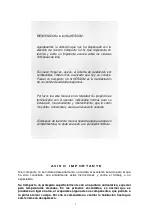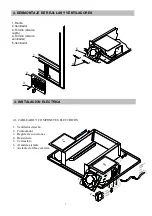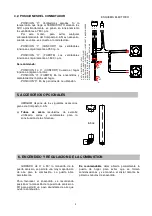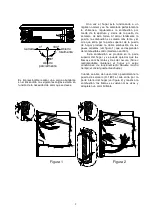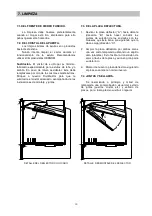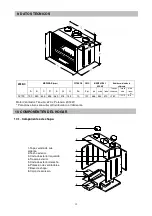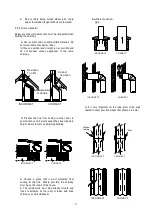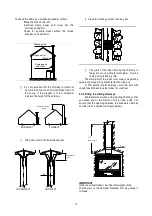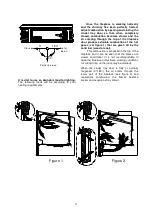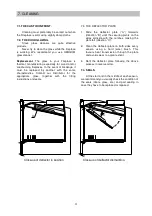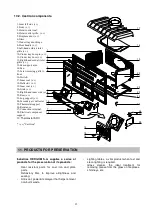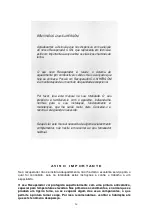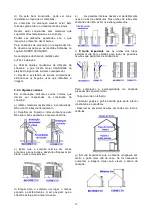
16
CHIMNEYS
The working order of the C.3.N Compact Fireplace
depends on:
a) The chimney.
b) The form of operating with it
c) The quality of the fuel used.
After years of use, you you may change the type of
fuel, although once the chimney is installed in a particular
spot, it is not easy to modify it or change its place. The
following information will help you decide whether you
can make us of the existing chimney or whether to decide
to build a new one.
2.2.1. How chimneys work
Basic knowledge of how chimneys work will help you to
make the most of your C.3-N Compact Fireplace, its main
functions being:
a) To evacuate the smoke and gases without danger
to the outside of the house.
b) To provide enough draught in the fireplace for the
fire to remain lit.
What is draught?
The tendency of the hot air to rise, creating draught.
When the C.3-N Compact fireplace is lit, the hot air rises
up the chimney and goes outside. The chimney flue heats
up and keeps the draught. Until the chimney is hot, the
draught will not work properly.
The location, size and height of the chimney affect its
draught.
The following must be taken into account:
-Chimneys located inside the home keep warm and,
therefore, the draught is greater.
-The recommended size of the chimney maintains a good
draught.
-The height of the chimney affects the draught. Greater
height: better draught. The chimney must stand out by at
least one metre above the highest part of the roof.
Other factors affect the draught:
-Trees and/or tall buildings close to the home.
-The wind speed. Generally, persistently strong winds
increase the draught, although stormy winds may
decrease the draught.
-Outside temperature. The colder it is outdoors, the better
the draught.
- Barometric pressure. On rainy, humid or stormy days,
the draught is generally weak.
-Liveliness of the fire. The hotter the fire, the stronger the
draught.
-Cracks in the chimney, a badly sealed or dirty door, air
inlets through the tube joints, other appliance connected
to the chimney, etc. may produce unsuitable draughts.
2.2.2. Creosote formation and cleaning
When wood is burned slowly, tars and other organic
vapours in the smoke duct are produced that, when
combined with atmospheric humidity, form creosote. The
creosote vapours can be condensed if the chimney walls
are cold. If the creosote catches alight, extremely hot fires
may be caused. Any accumulation of creosote must be
removed. It is difficult to know when the chimney must be
cleaned. A visual inspection is the safest way of knowing
whether the chimney of your fireplace is clean of creosote.
We therefore recommend installations to which access and
inspection are easy.
2.2.3. Options.
If you are going to build a chimney for your C.3-N
Compact fireplace, you have two alternatives:
a) Brickwork chimney.
b) Metal chimney.
Studies reflect that there is no great difference
between metal and brickwork in terms of draught.
According to your criteria, you will choose one or another.
Whenever possible, place your chimney inside the
home to obtain a better draught and accumulate less
creosote, leading to a longer working life.
THE ADVANTAGES OF BRICK CHIMNEYS ARE:
a) The mass of bricks and tiles reduces the cooling of
smoke in the chimney.
b) The characteristics of the bricks in accumulating
heat allows for the house to remain warm for
longer after the fire has been put out.
c) It may be built to individual tastes.
d) If it is well built, it may be more fire-resistant than
metal chimneys.
Brickwork chimneys must be well lined to avoid
smoke cooling. They must be built using materials that
withstand high temperatures and corrosion. They may be
round, square, etc. What matters is their size.
For brickwork chimneys in terms of the C.3-N
Compact Fireplace, the measures indicated in the
TECHNICAL DATA section 9 must be respected (Page 12).
THE ADVANTAGES OF METAL CHIMNEYS ARE:
a) Easy installation.
b) Slight changes in chimney direction can be made,
leading to greater flexibility in the choice of
location for the fireplace.

